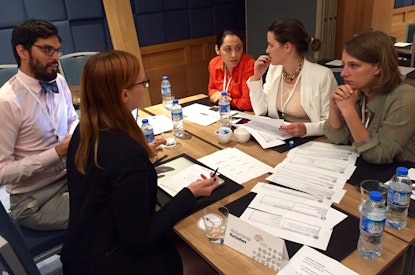Breaking down barriers to access information on public contracts: A focus on the user

What do users do when they’re asked to look up who the government contracted for a specific infrastructure project? A general online search usually comes first. The interested citizen may, with some luck, make it to the right contracting portal, only to realize that the database does not include a free text search. And how will they know the contract process I.D. (if there is one) or when the contract was awarded?
I ran this exercise, which is inspired by human-centered design approaches, in a session at the Data for Development event for Eastern Europe and Central Asia organized by UNDP. My colleague Tim Davies used a similar one at Transparency Camp Europe recently with useful findings.
The many barriers to accessing the data highlight a couple of the dilemmas we face when dealing with government data: How do we get citizens as well as the very same government officials who produce the data to use it?
So think about the use case first: One obvious way is to add a free text search field to the contracting platform. More importantly, though, we can make sure all contracts are included in the same platform. This is where our Open Contracting Data Standard comes in handy: it links information that is hosted on different platforms so that a search, for example, on Contracts Finder or Bund.de, will actually show the contracts and information you are looking for.
- With the exception of a couple of countries, I learned that procurement data in this region is generally not yet as open and available electronically as in other regions; especially as I flew in from Latin America where Colombia, Mexico, and Paraguay have been leaders in opening up public procurement by implementing open contracting. While some countries, such as Ukraine or Georgia have opened up their contract data, a detailed analysis of the Balkan region, presented by the Regional School of Public Administration at the open contracting panel of the conference, showed there is still some way to go. That said, Ukraine’s Prozorro platform is one of the best examples of open contracting and its positive impact on government savings (up to 14%) and business competition (by 50% and more than 6000 new buyers joined the system). More on that here.
- There are some strong civil society-driven use cases at the municipal level in Albania and Kosovo. The Albanian Institute of Science has opened up municipal level data on procurement, resulting in some fascinating cases of fraud being uncovered and covered widely in the media such as around the building of a tourist center.
Armend Vokshi, Chief of Administration of the Municipality Gjakova in Kosovo spoke about how useful open data can be in boosting local economic development and creating an environment for innovation. Open Data Kosovo’s e-procurement platform, e-prokurimi, showcases how to use the data to identify the regional spread of buyers, general spending trends and potential corruption risks in procurements.
- Open contracting is a key field in using open data for development, and it’s been mentioned as one of the areas with the clearest use case. Open contracting was one of three open data success stories mentioned at the conference by UNDP’s Istanbul Regional Hub Manager Rastislav Vrbensky. A focus on the use case is essential for open contracting data to be effective. Data requirements will change notably when looking at what citizens are interested in (was the infrastructure built?), what businesses are looking for (open tenders and trends, like this one for EU TED tenders) and what government officials need (savings and allocating spending). As Mustafa Nayyem, a member of the Parliament in Ukraine put it: Without reforming the public procurement system, we lose money with every day.
Journalist organizations, such as RISE in Moldova, rely on this information to conduct investigations. At the conference, Olga Ceaglei presented some of the group’s most exciting stories related to government contracting such as this one on a major road construction linking the capital Chisinau with Romania. - The process of developing an open data platform is just as important as opening up the data. The best approach is to use open standards and be transparent throughout the development process. The UK Government Service Design Manual’s technology code of practice provides some useful guidelines. The Ukrainian platform, ProZorro, as well as the U.S. government’s updated public spending website, USASpending.gov, are good examples of how this can work in practice. At the conference, Viktoria Mlynarcikova of the Ministry of Finance in Slovakia mentioned some of the pitfalls to watch out for. For example, don’t wait several years until the provider delivers a final product to test whether the platform works.
As Engine Room’s Alix tweeted: “Open data: Easy to do poorly, hard to do well.”
If done correctly, open contracting can change how a government works, not only how it talks about working. Our experience shows it is key to start small, test, iterate, then scale.
Clean contracts are vital for healthy societies, as these stories from the health sector in Romania and between Moldova and Bosnia show.
As with cleaning your teeth, you have to clean them every day to make sure they continue to shine (HT to Armend Vokshi for this awesome analogy). To make sure this is the case, we need the right tools. Open contracting and the Open Contracting Data Standard are essential to make sure we can develop them for users looking for information on public contracts.
We are looking forward to continuing our engagement in the region!